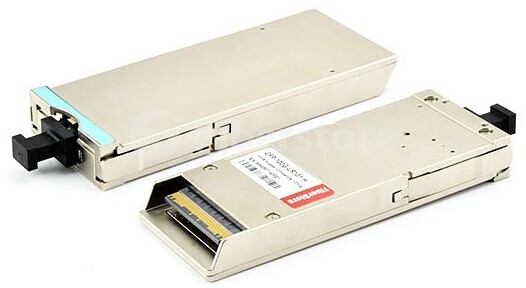CFP and QSFP Transceiver for 40G and 100G Network
In June 2010, IEEE published the IEEE 802.3ba standard for 40 Gigabit and 100 Gigabit Ethernet. The market for 100G Ethernet is driven by high bandwidth switching and routing for core network aggregation of 10G and 40G Ethernet links. 40G and 100G Ethernet networks are more and more installed to meet the increasing requirement for higher speed and more bandwidth.
The CFP transceiver is defined as hot-pluggable optical transceiver form factors to enable 40 Gbit/s and 100 Gbit/s applications, which is specified by a multi-source agreement to produce a common form-factor for the transmission of high-speed digital signals. The c stands for the Latin letter C used to express the number 100 (centum). CFP transceiver was designed after SFP transceiver interface, but it supports much larger internet speed — 100G, which is realized by using 10×10Gbit/s in each direction.
CFP transceiver is currently defined two next generation 100G form factors - CFP2 and CFP4. Compared to the existing CFP, CFP2 and CFP4 are respectively double and quadruple front panel port density. A brief introduction will be given to CFP2 and CFP4.

The 100Gbps CFP is designed to link IP routers, or an IP router to a DWDM platform for longer distance transmission. CFP transceivers are volume-deployed, mature and, low cost 10Gbps components, and ideally suited for 100Gbps extended reach inter-data center connections and wireless and wireline service back-hauling applications, at a most compelling cost point.
QSFP+/ CFP/ CXP are types of transceivers operating with 40/100GBASE parallel optics protocols. Generally, QSFP+ transceiver has a transfer rate of 40 Gbps, while CFP has a transfer rate of 40 Gbps or 100 Gbps. CXP is dedicated usually for 100G transmission and has a transfer rate of 100 Gbps. QSFP transceiver is a high performance, low power consumption, long reach interconnect solution supporting 40G Ethernet, fiber channel and PCIe. It is compliant with the QSFP MSA and IEEE P802.3ba 40GBASE-SR4. QSFP AOC is an assembly of 4 full-duplex lanes, where each lane is capable of transmitting data at rates up to 10Gb/s, providing an aggregated rate of 40Gb/s.
The Quad Small Form-factor Pluggable (QSFP) is a compact, hot-pluggable transceiver used for data communications applications in 40 Gigabit per second links. The 40 Gb/s QSFP+ transceiver is a fiber optical module with four channels. The QSFP specification accommodates Ethernet, Fibre Channel, InfiniBand and SONET/SDH standards with different data rate options. QSFP+ transceivers are designed to carry Serial Attached SCSI, 40G Ethernet, QDR (40G) and FDR (56G) Infiniband, and other communications standards. Commonly types of QSFP/QSFP+ optical transceivers on the market are QSFP-40G-PLR4, QSFP-40G-CSR4, 40GBASE-PLRL4, QSFP-40G-LR4, and QSFP-40G-SR4.
The QSFP is already the favoured interface for active optical cables that encapsulate the optics within the cable and which provide an attractive alternative to copper interconnect. QSFP transceivers support quad data rate (QDR) 4xInfiniband as well as extending the reach of 4x10Gbps Ethernet beyond copper's 7m. The QSFP is also an option for more compact 40GbE short-reach interfaces.
Fiberstore offers customers 40 Gigabit Ethernet and 100 Gigabit Ethernet connectivity options for data center networking, enterprise core aggregation, and service provider transport applications. Since the products are all in good quality and low price, it may be the best choice for you to deploy the network.